Unlocking Value Through a
Durable, Defensible Direction.
In our daily work with agency owners, one of most common discussions is identifying the optimal timing and strategy to sell their firm. Savvy operators know achieving a successful exit requires preparation and a strategic approach – yet, there’s so much noise to filter around “exit readiness”. To simplify, we often advise agency owners to think of preparation in a “3D” framework: Durability, Defensibility, and Direction. Let’s take a look at how these dimensions drive value and optionality for your transition.
1. “Durability” (Ensuring Stability and Predictability)
What It Means:
“Durability” refers to the stability and predictability of your agency’s team, customer base and overall performance. Potential buyers often look at the historic and current state to gain assurance that the agency will continue to thrive post-acquisition without significant disruptions.
Key Aspects:
- Team Stability: A cohesive and experienced management team is a significant asset. Buyers look for continuity in leadership and skilled employees who are likely to stay post-sale. Planning for retention strategies and incentive structures can help ensure key personnel remain committed.
- Customer Base: A diverse and loyal client base minimizes risk. Dependency on a few major clients can be a red flag, and often is calculated as a discount in valuation. Demonstrating long-term contracts and high client retention rates can enhance perceived stability.
- Financial Performance: Consistent revenue growth and profitability are attractive to buyers. Durable revenue matters, along with accurate financial statements that demonstrate steady performance, predictable cash flows and cash/expense management.
Why It Matters:
Buyers are more inclined to invest in an agency that exhibits low-risk factors and can maintain its operational and financial health independently of the current owner. Stability in these areas reassures buyers of the agency’s resilience and ongoing success, and helps the business stand out from the existing inventory of firms for sale.
2. “Defensibility” (Tangible, Unique Strengths)
What It Means:
“Defensibility” is about showcasing what makes your agency unique … and valuable. This includes proprietary products, specialized industry expertise, airtight go-to-market efficacy, or any competitive advantage that sets your agency apart.
Key Aspects:
- Proprietary Products and Services: Whether it’s a unique software solution, a specialized service offering, or a patented process, proprietary assets can significantly increase your agency’s value. These assets should be well-documented and protected by intellectual property rights where applicable.
- Industry Expertise: Expertise in a specific vertical or niche market can be highly attractive. Demonstrating thought leadership, deep industry knowledge, and a strong reputation within a particular sector can differentiate your agency from competitors. The proof is usually tied to success in acquiring, growing and keeping a specific customer profile.
- Go-To-Market: Innovative go-to-market strategies, effective customer acquisition methods, and access to a particular channel or market segment contribute to defensibility. Highlighting these strengths with trackable metrics over time can illustrate your agency’s competitive edge.
Why It Matters:
Defensible attributes provide buyers with confidence in the agency’s ability to maintain and grow its market position. It’s a moat that not only offers a high probability of delivering into the future, but also is a hedge against downside risk after the transaction (read more about the “J-Curve” here). These unique strengths act as barriers to entry for competitors, ensuring a sustained advantage for years to come.
3. “Direction” (Articulating a Clear Vision for Growth)
What It Means:
“Direction” is having a clear, strategic vision for the agency’s future. This includes demonstrating potential growth opportunities, scalability and the strategic initiatives to achieve future success. In recent years, operating models like EOS® have helped management teams document a one, five and ten year vision for the business, but more informal documentation is equally valuable.
Key Aspects:
- Growth Plan: A well-defined growth strategy that outlines potential market expansion, new service offerings and targeted investments can showcase the agency’s future potential. This plan should be realistic, backed by lucid assumptions and financial modeling.
- Scalability: Demonstrating the agency’s ability to scale operations efficiently is crucial. Buyers are interested in businesses that can grow without a disproportional increase in costs. The goal is to highlight processes and infrastructure that can scale.
- Visionary Leadership: A clear and compelling vision communicated by the leadership team can inspire confidence. This includes outlining the strategic direction and how the agency plans to navigate future industry changes and opportunities, specifically ensuring the business isn’t owner-dependent and has depth beyond the current CEO.
Why It Matters:
A compelling vision for the future not only attracts buyers but also ensures that the agency remains on a growth trajectory post-acquisition. Buyers are investing in the future potential of the agency, and a clear roadmap can significantly enhance its appeal and demonstrate what’s possible for the new owners.
Consider a Fourth D: “Day to Day”
The 3D model is focused on the business. But, how does it help the owner plan for their personal future? An often overlooked area of exit readiness is spending proper planning cycles on life after the sale. In other words, what’s important to you in the transition and transaction? Do you want a day-to-day role, and for how long?
Your identity and role will change. But, it’s too important of a moment to leave it to chance. The most fruitful transactions occur when the owner proactively thinks through details such as the targeted buyer type, terms, structure, timeline and future role (if any) in the new business. All to say, there are varying degrees of involvement and legacy at stake.
Mapping your personal desires may not get you more credit or enterprise value, but it will make the process of identifying, choosing and negotiating with your ideal partner more seamless and efficient. Deals break down for a variety of reasons, not the least of which is a change of heart or cold feet from a prospective seller when the deal just doesn’t “feel right”. This sentiment can be mitigated with upfront work to truly evaluate what’s important in the transition.
Selling your agency is one of the most important professional and personal pursuits you’ll experience. With proper planning and preparation, you can ensure your approach is aligned to the best outcomes and options for this important season.


